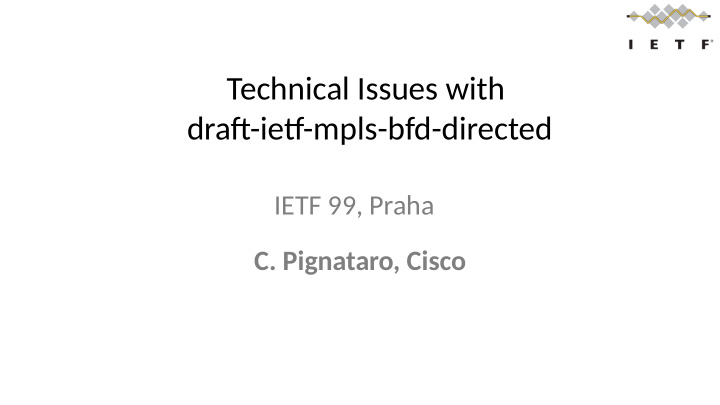



Technical Issues with drafu-ietg-mpls-bfd-directed IETF 99, Praha C. Pignataro, Cisco
Background • Loa Andersson’s email, July 12th: • 3 Unsuccessful WG LCs • Current Issues: IPR, Technical, Process • We will take half an hour of the allocated tjme for mpls wg to try to reach a point where a decision is possible. • Carlos, expect 10 min presentatjon on the technical issues (including questjons)
Background • 2nd WG LC on drafu-ietg-mpls-bfd-directed – htups://mailarchive.ietg.org /arch/msg/mpls/iXsENQuPWmmgsueNiUMlyRCcu 4U • “authors decided to remove sectjons Segment Routjng” – htups://mailarchive.ietg.org /arch/msg/mpls/imnwjd0the9F-F4gdHxh_J3xzq4
Background • (3rd) Re: [mpls] WGLC for drafu-ietg-mpls-bfd-directed – htups://mailarchive.ietg.org /arch/msg/mpls/iv-rCHGjiRVAndWOHnOiJ9HO2YY – htups://mailarchive.ietg.org /arch/msg/mpls/VZE_a1wL299Rjxav3SPT_QlgKCM • Authors then allowed multjple sub-TLVs – htups://mailarchive.ietg.org /arch/msg/mpls/rIuaKtXhkHCMUMEyYGI7zgZjcLQ
Background • [RTG-DIR] Rtgdir early review of drafu-ietg- mpls-bfd-directed-07 – htups://mailarchive.ietg.org/arch/msg/rtg-dir /CFfiXtm62K8j1BQPxNstqOPyYsA • Technical issues: lack specifjcatjon for interoperable implementatjon
Technical Issues: Motjvatjon • “For the case where a LSP is explicitly routed it is likely that the shortest return path to the ingress BFD peer would not follow the same path as the LSP in the forward directjon. The fact that BFD control packets are not guaranteed to follow the same links and nodes in both forward and reverse directjons is a signifjcant factor in producing false positjve defect notjfjcatjons, i.e. false alarms, if used by the ingress BFD peer to deduce the state of the forward directjon .”
Technical Issues: Motjvatjon • “a failure detectjon by ingress node on the reverse path cannot be interpreted as bi-directjonal failure unambiguously and thus trigger, for example, protectjon switchover of the forward directjon without possibility of being a false positjve. • To address this scenario the egress BFD peer would be instructed to use a specifjc path for BFD control packets.”
Technical Issues • Motjvatjon D D C C E E B B F F G G A A
New structure: FEC sub-TLVs • “Reverse Path fjeld contains a sub-TLV. Any Target FEC sub-TLV (already defjned, or to be defjned in the future) for TLV Types 1, 16, and 21 of MPLS LSP Ping Parameters registry MAY be used in this fjeld. None, one or more sub-TLVs MAY be included in the BFD Reverse Path TLV. If none sub-TLVs found in the BFD Reverse Path TLV, the egress BFD peer MUST revert to using the default, i.e., over IP network, reverse path.” • May it use the Nil FEC? PW 129 FEC? Multjcast FECs? • What if *some sub-TLVs” are found? • Any issues if the return LSP terminates mid stream?
RFC 5884 does not specify a Default • htups://tools.ietg.org/html/rfc5884#sectjon-7 • “ The BFD Control packet sent by the egress LSR to the ingress LSR MAY be routed based on the destjnatjon IP address as per the procedures in [BFD-MHOP]. If this is the case, the destjnatjon IP address MUST be set to the source IP address of the LSP Ping Echo request message, received by the egress LSR from the ingress LSR. • Or the BFD Control packet sent by the egress LSR to the ingress LSR MAY be encapsulated in an MPLS label stack. In this case, the presence of the fault detectjon message is indicated as described above. This may be the case if the FEC for which the fault detectjon is being performed corresponds to a bidirectjonal LSP or an MPLS PW. This may also be the case when there is a return LSP from the egress LSR to the ingress LSR. In this case, the destjnatjon IP address MUST be randomly chosen from the 127/8 range for IPv4 and from the 0:0:0:0:0:FFFF:7F00/104 range for IPv6.”
Persistency • Return Path Specified Label Switched Path (LSP) Ping • htups://tools.ietg.org/html/rfc7110 • However, 1. what if the return path is not initjally available? 2. Should the egress save this FEC stack? 3. Or if it goes down while the BFD session is UP?
Session Establishment • “If the egress LSR cannot fjnd the path specifjed in the Reverse Path TLV it MUST send Echo Reply with the received Reverse Path TLV and set the Return Code to " Failed to establish the BFD session. The specifjed reverse path was not found" Sectjon 3.3. The egress BFD peer MAY establish the BFD session over IP network as defjned in [RFC5884].”
Additjonal State? • How is the return path tracked? New state variable? htups://tools.ietg.org/html/rfc5880#sectjon-6.8.1
Switching over to a difgerent return path • How exactly? Text? • Does it depend on the ingress identjfying a change at egress? • Does this update RFC 5884 procedures?
Port Usage • The BFD Control packet sent by the egress LSR MUST have a well-known destjnatjon port 4784, if it is routed [ BFD-MHOP], or it MUST have a well-known destjnatjon port 3784 [BFD-IP] if it is encapsulated in a MPLS label stack. The source port MUST be assigned by the egress LSR as per the procedures in [BFD-IP]. • htups://tools.ietg.org/html/rfc5884#sectjon-7
Thank you! 16
Recommend
More recommend